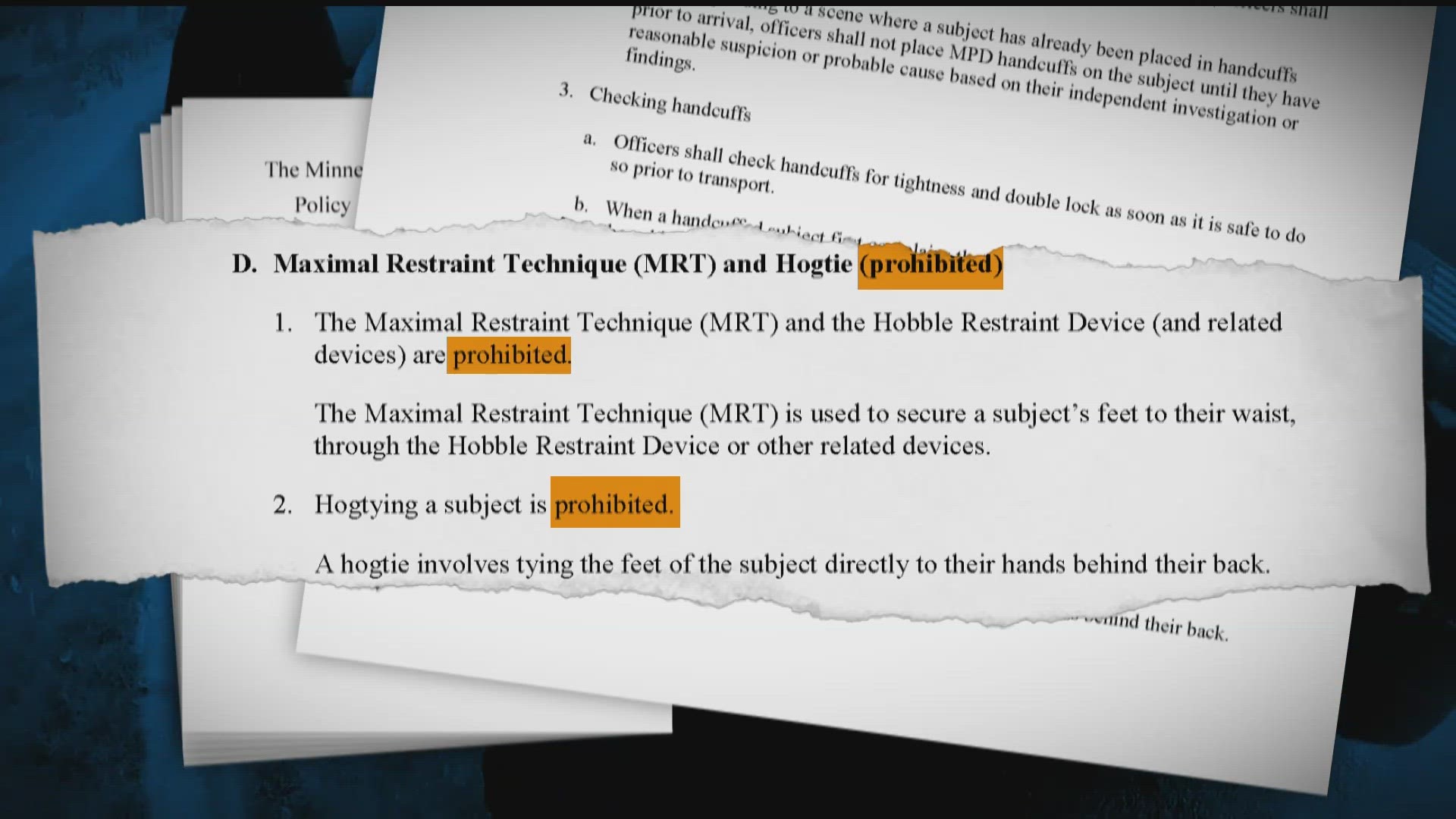MINNEAPOLIS — At the end of March, the Minneapolis Police Department updated its policy manual to ban restraint tactics.
According to the Minneapolis Police Department Policy and Procedure Manual, the "Maximal Restraint Technique (MRT) and the Hobble Restraint Device (and related devices) are prohibited."
During the trial of former Minneapolis police officer Derek Chauvin in the murder of George Floyd, restraint tactics became hot-button issues.
This is welcome news for attorney Abigail Cerra, who also chaired the now-defunct Minneapolis Police Conduct Oversight Commission. The group has since been revamped and is now called the Community Commission on Police Oversight. City councilors will vote to confirm its 15-member board on April 27.
"This is a really big change that's going to be felt immediately," said Cerra. "And it’s really telling the victims of police violence that we’re listening to you and we’re looking at our practices and finding where we can make changes."
Last week, the city of Minneapolis agreed to pay a nearly $9 million settlement to two people who were arrested by Chauvin in 2017. The plaintiffs, John Pope Jr. and Zoya Code, said Chauvin restrained them on the ground with his knee on their necks, which was determined to be a contributing factor in Floyd's death.
Before the update, the manual stated, "The maximal restraint technique shall only be used in situations where handcuffed subjects are combative and still pose a threat to themselves, officers or others, or could cause significant damage property if not properly restrained."
But before Chauvin's interactions with Code and Floyd, there was the story of David Smith. He died in 2010 after Minneapolis police officers kneeled on his back for about four minutes.
Part of the Smith family's settlement mandated that the department train its officers about the risks of that position, but it's unclear if that ever happened.
Cerra credits Smith's sister, Angela, for her persistence in bringing awareness to what happened to David.
"If she hadn’t spoken up and retraumatized and reshared that story, I, for one, never would have known about this," said Cerra. "If we simply left it to a single lawsuit or a single policy discussion behind closed doors, I don’t think this would have changed."
The next step is to ensure officers are held accountable if they continue to use these techniques. Cerra said that's the key to making this change meaningful.
"'What is the accountability?' is the million-dollar question, and that’s really the next thing that has to change with MPD," said Cerra.
Minneapolis Police Chief Brian O'Hara responded to KARE 11's questions about this news with a written statement:
“The first time I observed the Maximal Restraint Technique (MRT) being used on a person by MPD officers was during a review of body-worn camera footage related to the Code settlement agreement. Due to the obviously inhumane nature of the technique and the potential harm to those restrained by the MRT, I immediately placed a ban on the use of the MRT by MPD officers.
After this order was delivered, it was further made clear to me how infrequently the MRT had been used within the last year, and when it was used, it was deployed incorrectly most of the time. In fact, in the Code incident, not only had the MRT been deployed on someone who had clearly stopped resisting, the officers applied the device incorrectly and Zoya Code was able to work her way out of the restraint.
This further cemented my decision to unilaterally ban the use of the MRT due to the potential for harm to the restrained individual as well as its ineffectiveness at keeping officers safe.”
Watch more local news:
Watch the latest local news from the Twin Cities and across Minnesota in our YouTube playlist:
WATCH MORE ON KARE 11+
Download the free KARE 11+ app for Roku, Fire TV, and other smart TV platforms to watch more from KARE 11 anytime! The KARE 11+ app includes live streams of all of KARE 11's newscasts. You'll also find on-demand replays of newscasts; the latest from KARE 11 Investigates, Breaking the News and the Land of 10,000 Stories; exclusive programs like Verify and HeartThreads; and Minnesota sports talk from our partners at Locked On Minnesota.
- Add KARE 11+ on Roku here or by searching for KARE 11 in the Roku Channel Store.
- Add KARE 11+ on Fire TV here or by searching for KARE 11 in the Amazon App Store.
- Learn more about KARE 11+ here.

